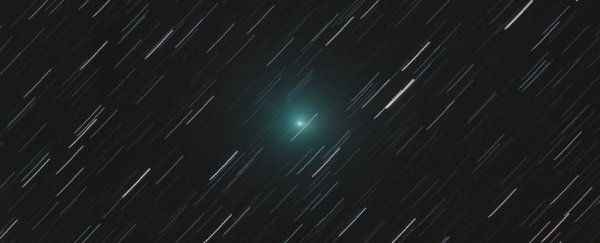An iconic comet will be zooming past Earth this weekend, just in time for April Fool's Day. Which, admittedly, does sound a little suspicious, but we promise this is definitely not a prank.
Comet 41P/Tuttle-Giacobini-Kresak was first detected back in 1858, and circles the sun every 5.5 years. This year, it will be making the closest flyby of Earth since its discovery, allowing us to catch an unprecedented glimpse as it zooms past at a very safe distance of around 21.2 million km (13.2 million miles) away.
That's a distance of 0.14AU, or a little over a tenth of the distance between Earth and the Sun.
Northern Hemisphere stargazers with small telescopes and potentially even binoculars will have the chance to see the comet from dark vantage points between dusk and dawn from now until mid-April, when it will be passing across the stars of the constellations Ursa Major and Draco.
But on April 1, the viewing will be particularly good, with the comet at its closet point to Earth since its discovery more than 150 years ago.
If you're more of a hobby skywatcher, are located in the Southern Hemisphere, or are struggling with bad weather, don't worry, you can watch it live here via Slooh's coverage from its telescopes on the Canary Islands, starting at Friday 31 March, 8.30pm EDT (Saturday 1 April, 00:30am UTC).
So what can you expect to see? Well, unlike the green comet that streaked past earlier this year, Comet 41P isn't particularly dazzling.
Comet 41P, as it's known for short, belongs to a group of comets known as Jupiter comets, which have been captured by Jupiter's massive gravity, and are now in orbit between the Sun and the gas giant.
It's also not particularly large - usually it appears in the night sky as a diffuse blob of light, no brighter than 8th magnitude, which means it's only as visible as Neptune in the night sky, and is roughly 50 times too faint to be seen with the naked eye.
Good binoculars or small telescopes will be needed to pick it out, as well as a dark, clear, moonless night.
But, this year could provide an exceptional opportunity - scientists are predicting that the comet could undergo a dramatic outburst in brightness as it approaches the Sun.
This happened back in May 1973, just before the comet arrived at perihelion - its closest point to the Sun.
Unexpectedly, the comet's brightness surged by 10 magnitudes, which meant it became 10,000 times brighter over just a few days, making it visible to the naked eye.
"Nobody knows for sure why the comet abruptly flared in 1973, but careful scrutiny of recent approaches to the sun in 1995, 2001, and 2006 suggest that outbursts in brightness tend to occur around the time [the comet] is passing closest to the Sun," explains astronomer Joe Rao, from New York's Hayden Planetarium, for Space.com.
The good news is that this year, perihelion occurs on April 12, just a little over a week after it zooms past Earth, which means we could be in store for another brightening event.
How dramatic that will be, or if it'll occur at all, is anyone's guess.
Just in case, we're going to be watching it from the comfort of our couches over at Slooh.
If nothing else, it's a good excuse to escape all the craziness of the internet on April Fool's Day with some much needed perspective about the vast scale of our Solar System, and all the fascinating objects that travel through it.
Happy skywatching!
